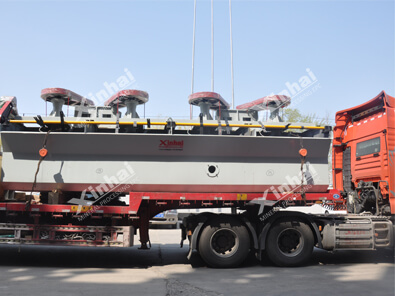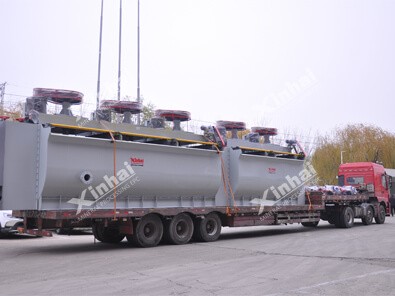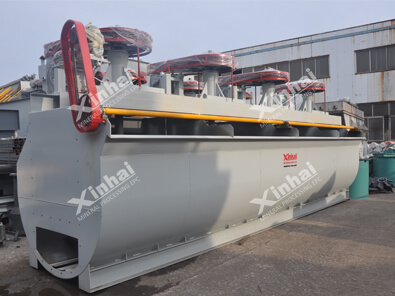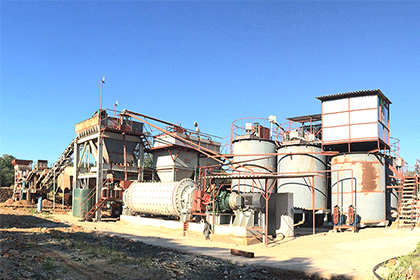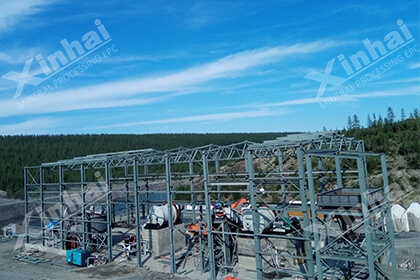Comprehensive Guide to Flotation Machines: Principles, Applications, and Recent Developments
 Essow
Essow
 Jun 29, 2023
Jun 29, 2023
 2608
2608
If you want to know more details about equipment, solutions, etc, please click the button below for free consultation, or leave your requirements!
01 Introduction
BackFlotation machines are an essential component in the mineral processing industry. They play a crucial role in the separation of valuable minerals from unwanted waste, enabling the production of high-quality concentrates. This comprehensive guide provides an in-depth look at the principles, applications, and recent developments in flotation technology.
02 Basics of Froth Flotation
BackFroth flotation is a physicochemical separation process that relies on differences in the surface properties of particles. It involves the selective attachment of hydrophobic particles to air bubbles, which then rise to the surface and form a frothy layer. The valuable minerals, trapped in the froth, can be skimmed off and collected, while the gangue (unwanted waste material) remains in the aqueous phase.
Froth flotation is a process used in the mineral processing industry to separate valuable minerals from unwanted materials. The process relies on the differences in surface properties between minerals and unwanted materials.
In the flotation process, a mixture of water, minerals, and a flotation agent (also known as a collector) is agitated to create a stable froth of bubbles. The flotation agent helps to form a stable froth of air bubbles, which attach to the mineral particles and cause them to rise to the surface, where they can be collected.
The flotation agent works by selectively binding to the surface of the mineral particles, making them hydrophobic (water-repelling). This causes the mineral particles to attach to the air bubbles, which are hydrophobic, and rise to the surface. The unwanted materials, which are hydrophilic (water-attracting), remain in the water and are removed as waste.
The froth of bubbles that forms on the surface of the mixture is collected and treated to separate the minerals from the water. The minerals are often further processed to extract the valuable metals or other materials.
The effectiveness of froth flotation depends on several factors, including the type of minerals being separated, the size and shape of the mineral particles, the concentration of the minerals in the mixture, and the properties of the flotation agent. The process can be optimized by adjusting these factors and by using advanced control systems to monitor and adjust the operating parameters of the flotation machines in real-time.
The flotation process is influenced by several factors, including:
Particle size
Pulp density
Reagent type and dosage
Air flow rate
Agitation
pH and temperature
Optimizing these factors is essential to achieving efficient and cost-effective separation.
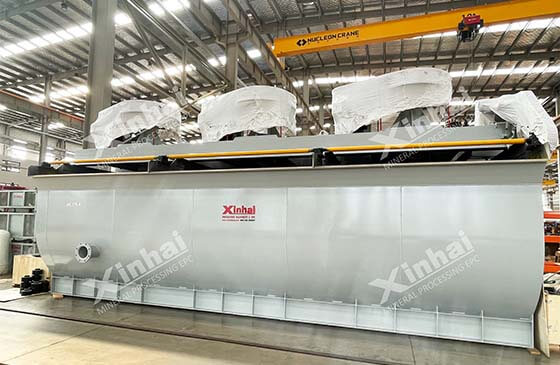
(Flotation Machine)
03 Flotation Machine Components
BackFlotation machines consist of several key components, including:
Tank: The tank is the vessel where the flotation process takes place. It is typically made of steel and is designed to withstand the pressure and wear and tear of the flotation process. The tank is often divided into several compartments to allow for multiple stages of flotation.
Agitator: The agitator is a device that mixes the mixture of minerals, water, and flotation agent in the tank. It can be powered by an electric motor, hydraulic motor, or other sources of power. The agitator helps to ensure that the minerals are evenly distributed throughout the tank, which is important for achieving an effective separation.
Feed pipe: The feed pipe delivers the mixture of minerals, water, and flotation agent to the tank. It is typically connected to a pump that delivers the mixture at a controlled rate.
Froth launder: The froth launder is a device that collects the froth of bubbles that has attached to the mineral particles. It is typically located at the top of the tank and is designed to allow the froth to overflow while minimizing the amount of water that is carried over.
Stators and rotors: Stators and rotors are components of mechanical flotation machines. The rotor is a spinning disk that generates air bubbles by agitating the mixture, while the stator is a stationary disk that helps to stabilize the froth and prevent it from collapsing.
Distributors: Distributors are devices that distribute the mixture of minerals, water, and flotation agent evenly throughout the tank. They are typically located at the bottom of the tank and help to ensure that the mixture is evenly distributed.
Control systems: Control systems are an important component of modern flotation machines. They use sensors and software to monitor and adjust the operating parameters of the machine in real-time, optimizing the performance of the machine and improving the accuracy and efficiency of the separation process.

(Structure of SF Flotation Machine)
04 Types of Flotation Machines
BackFlotation machines can be classified into two main categories: mechanical and pneumatic. Each type has its advantages and disadvantages, depending on the specific application.
4.1 Mechanical Flotation Machines
Mechanical flotation machines, also known as conventional flotation machines, are the most common type used in industry. They consist of a series of cells arranged in a row, with each cell containing an impeller-driven rotor that rotates to create turbulence and disperse air bubbles into the slurry. Mechanical flotation machines are further divided into three subcategories:
Self-aerating cells: These cells rely on the suction created by the impeller to draw in air and disperse it into the slurry.
Forced-air cells: Pressurized air is directly supplied to the cell, providing a more uniform bubble distribution.
Sub-aeration cells: A combination of self-aerating and forced-air mechanisms is used, with air being introduced both through the impeller and via an external blower.
4.2 Pneumatic Flotation Machines
Pneumatic flotation machines, also known as column flotation machines, consist of a tall column filled with slurry and air bubbles. The key advantage of pneumatic flotation machines is their ability to generate smaller and more uniform air bubbles, resulting in improved mineral recovery and concentrate grade. There are two main types of pneumatic flotation machines:
Non-agitated columns: These columns rely on the natural circulation of slurry and air within the column to create turbulence and promote particle-bubble attachment.
Agitated columns: A mechanical agitator is used to create turbulence and disperse air into the slurry.

(Flotation Machine)
05 Industrial Applications
BackFlotation machines are widely used in various industries for the separation of valuable minerals from gangue. Some of the most common applications include:
Mineral processing: Flotation is a key process in the recovery of minerals such as copper, lead, zinc, molybdenum, gold, silver, and platinum group metals. It is also used to separate coal from waste rock in coal preparation plants.
Wastewater treatment: Flotation is employed to remove contaminantsand suspended solids from industrial wastewater, allowing for the reuse of treated water or safe discharge into the environment.
Oil sands processing: The bitumen froth flotation process is used to separate bitumen from sand, clay, and water in oil sands extraction operations.
De-inking: The paper recycling industry uses flotation to remove ink particles from recovered paper fibers, improving the quality of the recycled product.
Biotechnology: Flotation techniques have been adapted for the separation and concentration of microorganisms, proteins, and other biomolecules in bioprocesses.
06 Recent Developments
BackThe field of flotation technology has seen several recent advancements in terms of equipment design, operational efficiency, and environmental impact. Some notable developments include:
Improved instrumentation and control: Advanced sensors, process control systems, and machine learning algorithms have been integrated into modern flotation machines, allowing for real-time monitoring and optimization of the flotation process.
Energy-efficient designs: Newer flotation machines have been developed with a focus on minimizing energy consumption, often through the use of more efficient impellers and air injection systems.
Environmentally friendly reagents: Researchers are exploring the use of environmentally benign surfactants and collectors to replace traditional reagents, which can be toxic and difficult to manage in the environment.
Hybrid flotation systems: Combining different flotation techniques, such as mechanical and pneumatic cells, can lead to improved performance and increased operational flexibility.
Modular and mobile flotation plants: The development of compact, modular, and mobile flotation plants allows for more rapid installation and commissioning, reducing capital costs and enabling greater flexibility in the placement of processing facilities.
07 Conclusion
BackFlotation machines play a vital role in the separation of valuable minerals from unwanted waste, enabling the production of high-quality concentrates. This comprehensive guide has provided an overview of the fundamental principles of froth flotation, the key components of flotation machines, the different types of machines available, their industrial applications, and recent advancements in the field.
As the demand for high-quality mineral concentrates continues to grow, the development and implementation of advanced flotation technologies will play a crucial role in meeting this demand. Researchers and practitioners in the field must continue to innovate and optimize flotation processes to ensure the efficient and sustainable recovery of valuable resources.
Besides, we have articles about flotation machines, please click the link to check them. What is Flotation Process in Mining Industry? Flotation Tanks Types and Selection Working Principle of 5 Types Of Flotation Machines
 +86 18716000713
+86 18716000713 xlyin@xinhaimining.net
xlyin@xinhaimining.net




 Message
Message Chat Now
Chat Now


